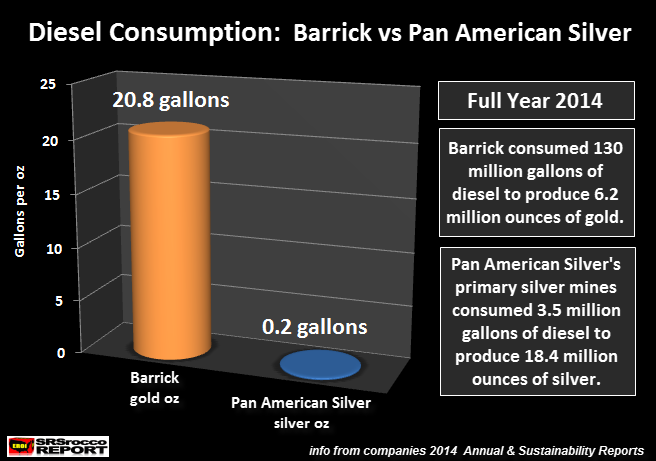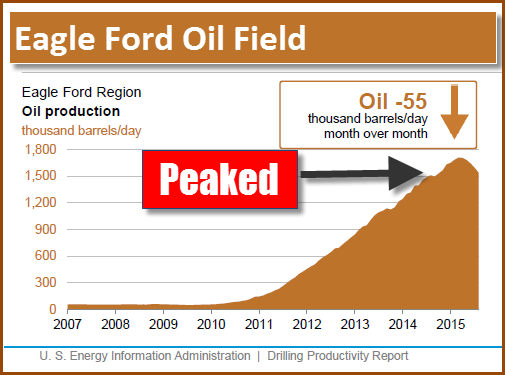If you are a precious metals investor, you need to see this chart. Matter-a-fact, this is the first time (to my knowledge) in the history of precious metals analysis that the information in this chart has been made public. One look at this chart and the investor will see the the huge difference between the cost to produce the precious metals.
In addition, the information in this chart will show why the peak of primary gold production will occur before the peak of primary silver production. However, global silver production will likely peak soon after world gold production. Thus, individuals understanding the difference, will likely enjoy a rewarding investment strategy most are currently unaware.
As I have mentioned time and time again, ENERGY IS THE KEY to the value of the precious metals. This goes well above and beyond the percentage of raw energy (oil, natural gas, coal, hydro & nuclear) consumed in the production of an ounce of gold or silver. Unfortunately, investors do not realize that 90-95% of the value of an ounce of gold or silver is directly related to the amount of energy consumed IN ALL FORMS and IN ALL STAGES in the their production.
Labor is a form of energy. Upper management pay, is a form of energy (highly skilled energy). The materials consumed in the gold and silver mining industry get their value from the energy consumed IN ALL FORMS and in ALL STAGES of their production-transportation-distribution. The mining equipment used in the production of gold and silver also get their value from all the energy consumed in their manufacture (in all forms and stages).
While the market understands that energy is large percentage of the cost to produce gold or silver, they fail to realize LABOR, MATERIALS and EQUIPMENT are all “Energy Derivatives.” Even though labor, materials and equipment are listed as different itemized costs on the precious metals mining company’s balance sheet, they are all ENERGY COSTS when we break them down to their simplest form.
That being said, let’s look at the huge difference in the consumption of diesel in the primary gold and silver mining industry. I selected Barrick because they are the largest gold producer in the world and Pan American Silver is one of the largest primary silver mining companies. While other companies such as Fresnillo located in Mexico produce more silver than Pan American Silver, I was able to obtain diesel consumption data from Pan American Silver more readily as they just released their 2014 Sustainability Report.
If we look at the chart below, we can see just how much more diesel is consumed in the production of gold than silver:
According to the data from the two companies 2014 Sustainability Reports, Barrick consumed 20.8 gallons of diesel to produce an ounce of gold while Pan American Silver only used 0.2 gallons to yield an ounce of silver. Basically, it took Barrick 100 times more diesel to produce an ounce of gold in 2014 than it took Pan American Silver to produce an ounce of silver.
That said, let me clarify a few things. First, these mining companies state their energy consumption figures in various metrics. For example, Barrick listed their energy consumption in giga joules and Pan American Silver in cubic meters. So, we have to make some conversions to gallons to make a comparison.
Secondly, I took all of Barrick’s estimated diesel consumption and divided it by the total amount of gold produced in 2014. However, I only used Pan American Silver’s five primary silver producing mines to calculate their diesel consumption. Pan American Silver has two additional mines (Dolores & Manantial Espejo) that produce a great deal of gold. Thus, these two mines consume a lot of energy, similar to primary gold mines.
Furthermore, the revenue obtained from Pan American Silver’s Dolores and Manantial Espejo Mines was higher in percentage of gold than silver. So, I omitted these two mines when calculating a more ideal energy consumption metric for the primary silver mining industry.
For those who like to see the actual data, here it is below:
BARRICK 2014
Total Diesel Consumed = 129 million gals
Total Gold Production = 6.2 million oz
Diesel consumed per oz of gold = 20.8 gal
PAN AMERICAN SILVER 2014
Diesel Consumed by 5 Primary Silver Mines = 3.5 million gals
Total Primary Silver Production (5 mines) = 18.4 million oz
Diesel Consumption per oz of silver = 0.2 gals
Yes, it’s true that Pan American Silver produced 26.1 million oz (Moz) in 2014, but remember, I had to subtract the 7.7 Moz supplied by the Dolores and Manantial Espejo Mines as they were more a primary gold mine with silver by-product (or co-product) credits.
Peak Gold vs Peak Silver: How Will This Play Out?
The question many investors may ask after reading the information above is… What do these figures mean? This is a good question. Why? Because, I believe it will provide some favorable investment strategies for precious metals investors that aren’t presently understood.
One of the things I try to do on my site is to show how energy will impact the precious metals, the miners and the overall economy going forward. However, when I post an energy article, it goes over like a FART IN CHURCH. My energy articles receive a tenth of the readership compared to some of my more popular precious metal articles. And this is quite a shame, because ENERGY IS THE KEY to understanding how the world collapses or evolves going forward.
As I stated in a recent article, U.S. Shale oil production already peaked earlier this year. ITS A DONE DEAL. So, for all the folks who continue to believe the CRAPOLA put out by the U.S. Govt or MSM that the U.S. is still on track to be energy independent…. WAKE UP, it’s a big lie.
With the peak of U.S. Shale oil production already in the rear-view mirror, I believe we will see the peak of global oil production very soon. Thus, the world will have LESS and LESS oil in the future each year to run the system… and this includes the mining industry.
If we consider that it takes the primary gold mining industry (on average) 100 times more diesel to produce an ounce of gold than the primary silver mining industry, peak oil will impact the gold mining industry a great deal more than the primary silver mining industry. Which is why I believe we will see a peak of primary gold production before primary silver production.
However, that doesn’t mean global silver production will peak many years after primary gold production. Why? Because 70% of global silver mine supply comes as a by-product of base metal and the gold mining industries. As global oil production peaks and declines, it will also cause World GDP to fall. Falling Global GDP means less economic activity… thus less demand for base metals.
We will see less available diesel for the base metal mining industry, or less demand for the metals. Either way, global peak silver production will be a result of the peak of base metal mining, not primary silver mining. Matter-a-fact, I actually see growth in the primary silver mining industry for several years after peak oil due to two factors:
1) The relatively small amount of diesel consumed in producing primary silver
2) The skyrocketing price of silver (due to the collapse of fiat money and paper assets) and its positive impact on the primary silver mining industry.
While most analysts continue to push resource stocks as wise investments, there are very few worth owning. For example, the folks at Stansberry & Associates have been cheerleaders for the U.S. energy industry, and in many cases… the shale energy companies. I have said from the beginning, Shale Oil & Gas Companies (for the most part) are dogs and will continue to be dogs. I just read in a recent Stansberry Portfolio Update the following:
….we are closing the XXX (can’t provide energy stock name) position and will no longer cover the stock. We will record a loss of 153% on margin (31% on capital at risk) in our official portfolio.
I don’t want to seem brazen here, but if some of their investors read my articles on energy FOR FREE instead of paying Stansberry & Associations an ARM & LEG for their investment advice, they wouldn’t have lost 153% of their money investing in one hell of a lousy shale energy company stock.
Now, don’t get me wrong, I am not singling out Stansberry & Associates… as we in the precious metal community deserve some blame for underestimating how long the Fed and Central Banks could prop up the markets and drive the paper price of gold and silver much lower. However, owning most resource stocks that will only go lower in value is different from owning physical precious metals that will only go higher in the future.
Precious metals investors haven’t lost value in their physical gold and silver holdings, unless they are unwise and sell them now. This is much different from investing into worthless resource stocks that will only continue to lose value going forward.
Okay, if you follow my drift on why primary gold miners will peak before primary silver miners, the Primary Silver Mining Industry may offer a much better investment strategy in a peak oil environment. Of course, there are no guarantees, but I do see the primary silver mining industry growing for a while, even after the world peaks in global oil production.
I believe silver will become one of the most sought after physical assets to own in the future as the majority of paper and physical assets lose value. This will make the primary silver miners’ margins-profits quite handsome… as well as their stock price. However, if you are going to invest in the primary silver mining “producers” (not explorers), do so with money you can lose. Make sure you have your nest egg of gold and silver bullion first before you invest some throw-away money in the primary silver miners.
The reasoning here is… if the primary silver mining stock you purchased is either nationalized or shut down for whatever reason in the future, you only gambled money you didn’t need. This not only allows one to sleep better at night, but it also is a smart way to invest one’s capital.
Please check back for new articles and updates at the SRSrocco Report. You can also follow us at Twitter below:





